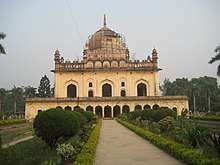Bahu Begum ka Maqbara
| Bahu Begum ka Maqbara | |
|---|---|
 Tomb of Unmatuzzohra Bano Begum alias Bahu Begum | |
| Location | Faizabad, India |
| Coordinates | 26°45′58″N 082°08′40″E / 26.76611°N 82.14444°ECoordinates: 26°45′58″N 082°08′40″E / 26.76611°N 82.14444°E |
| Elevation | 335 ft (102 m) |
| Built | 1816[1] |
| Architect | Darab Ali Khan |
| Architectural style(s) | Nawabi` |
| Type | Cultural |
| State Party |
|
Bahu Begum ka Maqbara is the Tomb of Queen Bride Begum Unmatuzzohra Bano alias Bahu Begum a memorial built for queen of Nawab Shuja-ud-Daula. Its one of the tallest buildings in Faizabad and is a notable example of non-mughal Muslim architecture. The Mausoleum of Bahu Begum created by Nawab Suja-ud-Daula in the memory of his loving wife is famous for the creative architectural brilliance with which it was designed and constructed.[2] Shuja-ud-daula's wife was the well known as Bahu Begum, who married the Nawab in 1743 and continued to reside in Faizabad, her residence being the Moti-Mahal. Close by at Jawaharbagh lies her Maqbara, where she was buried after her death in 1816. It is considered to be one of the finest buildings of its kind in Avadh, which was built at the cost of three lakh rupees by her chief advisor Darab Ali Khan. A fine view of the city is obtainable from top of the begum's tomb. Bahu Begum was a woman of great distinction and rank, bearing dignity. Most of the Muslim buildings of Faizabad are attributed to her. From the date of Bahu Begum's death in 1815 till the annexation of Avadh, the city of Faizabad gradually fell into decay. The glory of Faizabad finally eclipsed with the shifting of capital from Faizabad to Lucknow by Nawab Asaf-ud-Daula.[3]
History
Excerpts from the cite www.columbia.edu: “Bahu Begum” (H.H. Nawab ’Umat uz-Zohra Begum Sahiba) was the widow of the third Nawab of Avadh or Oudh, Shuja-ud-Daula (H.H. Shuja ud-Daula, Nawab Mirza Jalal ud-din Haidar Khan Bahadur, Nawab Wazir of Oudh, r. 1754-75). Her maqbara, “the finest building of the kind in Oudh” (Carnegy, Woodburn & Noble 1870: 26) was not completed before 1858. This date is important since Umrao Jan expressively mentions that her father worked there as “jamadar”. In A Historical Sketch of Tahsil Fyzabad, Zillah Fyzabad, including Parganas Haveli Oudh and Pachhimrath, with the old Capitals Ajudhia and Fyzabad, Pargana Mangalsi and Pargana Amsin, Lucknow 1870, the account on this monument is as follows: “The Bahu Begam’s Mausoleum. It was arranged by treaty between the British Government,the Bahu Begam, and the Nawáb of Oudh, that 3 lacs of sicca Rs. of her riches, were to be set apart for the erection by her confidential servant Daráb Alí Khán, of her tomb, and that the revenue of the villages to the aggregate amount of sicca Rs. 10,000 per annum, were to be assigned for its support. The Begam died on the 27th of January 1816. Daráb Alí laid the foundations and built the plinth, when he also died, on the 10th of August 1818. Panáh Alí, vakíl, and Mirzá Haider, the son of an adopted daughter then carried on the work through a series of years when, with the completion of the brick work, the grant of 3 lacs came to an end, and the beautiful edifice remained unfinished till after the mutiny of 1857.” (ibid.: 26).[4]
The Nawabs graced Faizabad with several buildings, notable among them are the Gulab Bari, Moti Mahal and the Bahu Begum ka Maqbara. Gulab Bari is a building standing in a garden surrounded by a wall, approachable through two large gateways.[5] The tomb built in 1816 from white marble was an attempt to recreate the grandeur of the Taj Mahal at a cost of Rs 3 lakhs. The marble used almost 200 years ago still shines its brightest and provides the Mausoleum of Bahu Begum an aura of immortality. Rising up to 42 meters the tomb also affords views of the Faizabad town and its surroundings. This royal monument in memory of a dignified woman has been maintained well and even today the care taken by the Archaeological department is evident.[6]
फ़ैज़ाबाद के इसी मक़बरे में नवाब आसफ़ुद्दौला की माँ ख़ुर्शीद महल का ख़ज़ाना रखा था. कर्नल हंट ने इस पर हमला करके तकरीबन 80 लाख रुपए के ज़ेवरात लूट लिए थे.[7]
Negligence
Sadly, this monument is a victim of neglect and is crumbling.
Gallery

 A lamppost with fish motif inside Maqbara
A lamppost with fish motif inside Maqbara- Facade of Maqbara
- another view of Maqbara
- Ramparts of Maqbara
- The main entrance way of Maqbara is lined with palm trees
 Stucco work on the ceiling of Maqbara
Stucco work on the ceiling of Maqbara- Maqbara exterior
- Arched entrance to halls inside Maqbara.
- Maqbara
- A hall inside maqbara of bahu begum, the mausoleum of queen bride of Avadh. This is where the religious gather or a 'majlis' is held.
- photograph taken of the main gateway entrance of Bahu Begum ka Maqbara in Nov 2010.
References
- ↑ "Mausoleum of Bahu Begum".
- ↑ "Environmental Information System Uttar Pradesh". Directorate of Environment U.P. Archived from the original on 2011-12-21.
- ↑ "Welcome to Faizabad History". official website of Faizabad district.
- ↑ "PRAJÑÅDHARA" (PDF). www.columbia.edu.
- ↑ "Welcome to Faizabad History". official website of Faizabad district.
- ↑ "Mausoleum of Bahu Begum".
- ↑ "1857 के विद्रोह के अहम केंद्र". BBC.